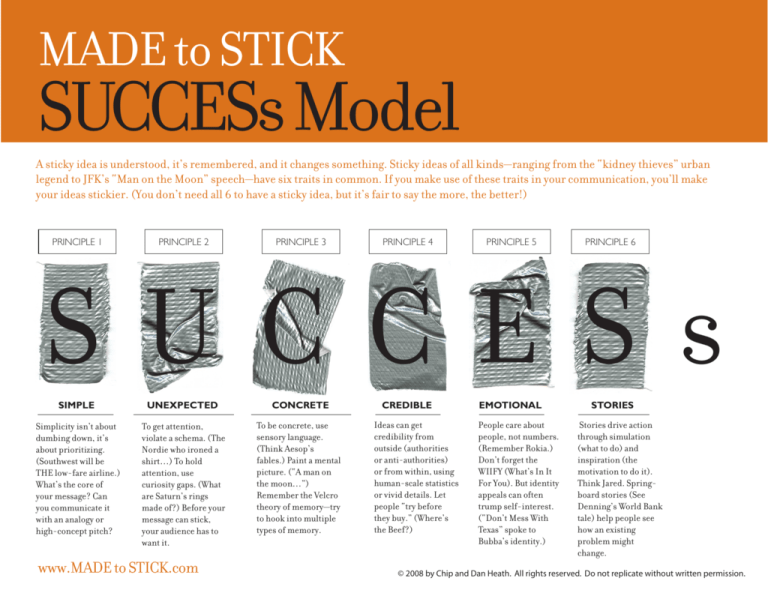
MADE to STICK
SUCCESs Model
A sticky idea is understood, it’s remembered, and it changes something. Sticky ideas of all kinds—ranging from the “kidney thieves” urban
legend to JFK’s “Man on the Moon” speech—have six traits in common. If you make use of these traits in your communication, you’ll make
your ideas stickier. (You don’t need all 6 to have a sticky idea, but it’s fair to say the more, the better!)
PRINCIPLE 1
PRINCIPLE 2
PRINCIPLE 3
PRINCIPLE 4
PRINCIPLE 5
PRINCIPLE 6
SUCCESs
SIMPLE
UNEXPECTED
CONCRETE
Simplicity isn’t about
dumbing down, it’s
about prioritizing.
(Southwest will be
THE low-fare airline.)
What’s the core of
your message? Can
you communicate it
with an analogy or
high-concept pitch?
To get attention,
violate a schema. (The
Nordie who ironed a
shirt…) To hold
attention, use
curiosity gaps. (What
are Saturn’s rings
made of?) Before your
message can stick,
your audience has to
want it.
To be concrete, use
sensory language.
(Think Aesop’s
fables.) Paint a mental
picture. (“A man on
the moon…”)
Remember the Velcro
theory of memory—try
to hook into multiple
types of memory.
www.MADE to STICK.com
CREDIBLE
Ideas can get
credibility from
outside (authorities
or anti-authorities)
or from within, using
human-scale statistics
or vivid details. Let
people “try before
they buy.” (Where’s
the Beef?)
EMOTIONAL
People care about
people, not numbers.
(Remember Rokia.)
Don’t forget the
WIIFY (What’s In It
For You). But identity
appeals can often
trump self-interest.
(“Don’t Mess With
Texas” spoke to
Bubba’s identity.)
STORIES
Stories drive action
through simulation
(what to do) and
inspiration (the
motivation to do it).
Think Jared. Springboard stories (See
Denning’s World Bank
tale) help people see
how an existing
problem might
change.
© 2008 by Chip and Dan Heath. All rights reserved. Do not replicate without written permission.












